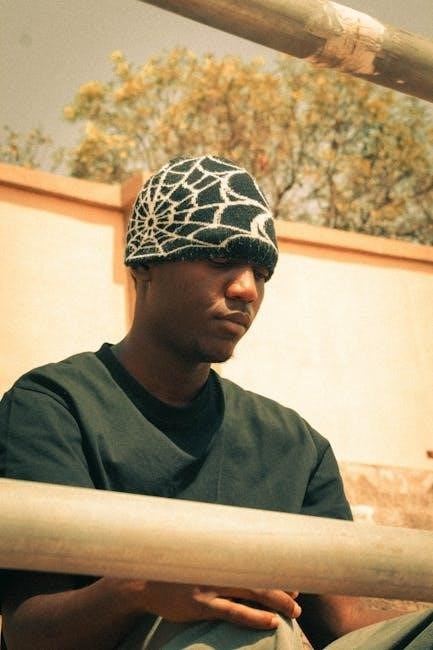
Crochet beanie size guides ensure your projects fit perfectly, covering measurements, gauge swatches, and customization․ Whether for personal use or gifting, this guide helps you achieve a perfect, professional finish every time․
Importance of Proper Fit in Crochet Beanies
A proper fit is essential for crochet beanies to ensure comfort, functionality, and a polished appearance․ Ill-fitting beanies can be uncomfortable or impractical, while a well-fitted one stays in place, regulates temperature, and enhances style․
Correct sizing ensures the beanie serves its intended purpose, whether for warmth, fashion, or as a gift․ Achieving the right fit boosts confidence and satisfaction in your crochet projects․
Understanding Crochet Terminology for Beginners
Mastering basic crochet terms is crucial for creating well-fitting beanies․ Gauge refers to the number of stitches and rows per inch, ensuring your fabric is the correct density; Circumference measures the head’s width, while stretch determines how much the fabric gives․
Terms like stitch patterns (e․g․, single crochet, half double crochet) and hook sizes are essential for achieving the desired texture and size․ Understanding these basics helps you interpret patterns and adjust sizes accurately for a perfect fit․
Understanding Measurements for Crochet Beanies
Accurate measurements are key to a proper fit․ Understanding circumference, height, and stretch ensures your crochet beanie is comfortable and well-fitting․ Gauge swatches help maintain consistency․
Types of Measurements: Circumference, Height, and Stretch
Crochet beanie sizing relies on three key measurements: circumference, height, and stretch․ Circumference measures head size, ensuring a snug fit․ Height determines the beanie’s length for style․ Stretch accounts for yarn elasticity and comfort․
How to Measure Your Head for a Perfect Fit
To ensure a perfect fit, measure your head circumference using a flexible tape measure or a piece of string․ Place the measure around the widest part of your head, just above your eyebrows and ears, keeping it level and smooth․ If using a string, wrap it around your head, mark the overlap point with a pencil, and measure the length with a ruler․ For accuracy, measure in the morning when your head shape is most consistent․ Avoid pulling the tape too tight or leaving it too loose for the best results․
Using Gauge Swatches for Accurate Sizing
A gauge swatch is essential for ensuring your crochet beanie fits perfectly; Crochet a swatch using the same hook, yarn, and stitch pattern as your project․ Measure the number of stitches and rows within a 4×4 inch square to confirm it matches the pattern’s gauge․ If your gauge is too loose, your beanie may be too big, and if too tight, it may be too small․ Adjust your hook size accordingly to achieve the correct tension for a professional finish and proper fit․
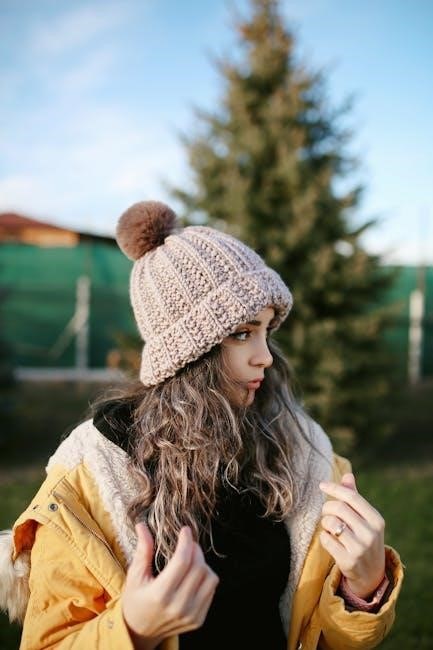
Standard Crochet Beanie Sizes
Standard sizes include Small, Medium, Large, and X-Large, typically fitting head circumferences from 20-24 inches․ Patterns often provide measurements to ensure a tailored, comfortable fit for all ages․
Size Charts for Adults: Small, Medium, Large, and X-Large
Adult crochet beanie sizes typically range from Small (20-21 inches) to X-Large (24-25 inches) in head circumference․ Medium fits 22-23 inches, while Large covers 23-24 inches․ These standard measurements ensure a comfortable, snug fit for most adults․ Patterns often include specific stitch counts or rounds to achieve the desired size․ By following these guidelines, crocheters can create beanies that are neither too tight nor too loose, ensuring optimal comfort and style for any wearer․
Size Charts for Children: Baby, Toddler, and Youth Sizes
Children’s crochet beanie sizes vary based on age and head circumference․ Baby sizes (0-12 months) typically fit 16-18 inches, while Toddler sizes (1-3 years) range from 18-20 inches․ Youth sizes (4-12 years) accommodate 20-22 inches․ Patterns often include adjustments for growth spurts and comfort․ By following these size charts, crocheters can create beanies that fit securely without being restrictive, ensuring comfort and style for growing children․
How to Adjust Patterns for Different Head Sizes
Adjusting crochet patterns for different head sizes involves modifying stitch counts, hook sizes, or row numbers․ Start by measuring the intended head circumference․ Increase or decrease the number of starting stitches proportionally, maintaining the pattern’s shape․ For example, adding or subtracting stitches in increments of 10-15 ensures a proper fit․ Similarly, changing hook sizes can subtly alter the beanie’s size․ Always swatch to ensure gauge accuracy, as small adjustments can significantly impact the final fit․ This method ensures a customized, comfortable beanie for any head size․
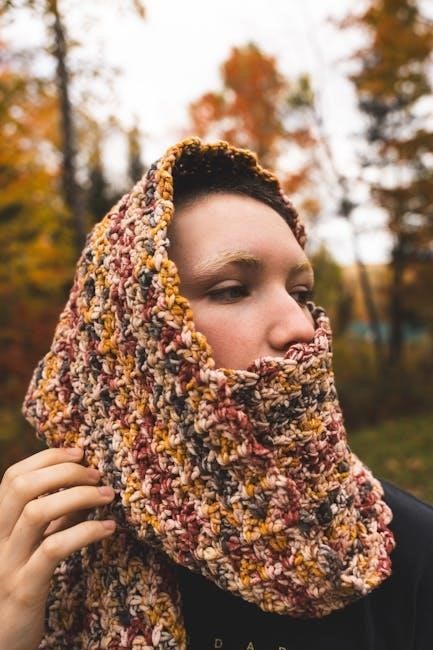
Choosing the Right Hook and Yarn for Size Accuracy
Hook size and yarn weight significantly impact beanie size․ Correct tools ensure proper fit․ Gauge accuracy is key for consistent results․ This ensures a beanie․
Hook Sizes and Their Impact on Beanie Size
Hook size plays a crucial role in determining the final size of your crochet beanie․ A larger hook creates a looser fabric, resulting in a bigger beanie, while a smaller hook produces a tighter fabric, leading to a smaller size․ Using the correct hook size ensures the beanie meets the desired measurements and maintains the intended texture․ Deviating from the pattern’s recommended hook size can significantly alter the fit, so it’s essential to stick to the guidelines or adjust intentionally for customization․ Always measure gauge to confirm accuracy․
Yarn Weight and Fiber Types: How They Affect Size
Yarn weight and fiber type significantly influence the size and fit of a crochet beanie․ Thicker yarns create a larger, bulkier fabric, while finer yarns result in a smaller, more delicate texture․ Natural fibers like wool offer elasticity, ensuring a snug fit, while synthetic fibers may lack stretch․ Blends combine these properties, offering a balance of durability and flexibility․ Choosing the wrong yarn weight or fiber can alter the beanie’s size and drape, so it’s crucial to select yarns that match your pattern’s requirements for the best fit and desired aesthetic․
Using Substitution Yarns Without Compromising Fit
When substituting yarns, ensure the weight and fiber match the pattern’s recommendations to maintain size consistency․ Check yarn labels for weight categories and fiber content․ Swatch before starting to confirm gauge, as even similar yarns can behave differently․ Measure gauge accurately and adjust hook size if needed․ Small variations in yarn texture or weight can affect fit, so testing is crucial to achieve the desired size and drape without compromising the beanie’s shape or comfort․
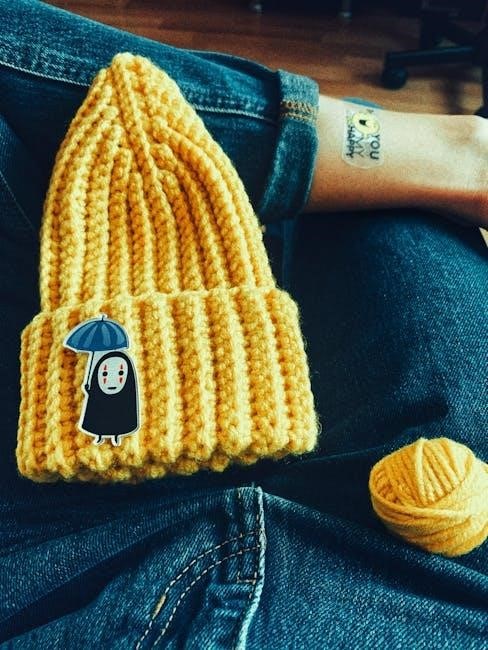
Calculating Gauge for Crochet Beanies
Crochet gauge measures stitches per inch, crucial for accurate sizing․ To calculate, crochet a swatch, count stitches and rows in a 4-inch area, and adjust hook size as needed to match the pattern’s specifications․ This ensures a proper fit and desired texture, especially when substituting yarns or adjusting patterns for different sizes or yarn weights․ Regular gauge checks help maintain consistency and achieve professional-looking results in your crochet projects․ Gauge is fundamental for ensuring your beanies are neither too tight nor too loose․ Always measure gauge accurately to ensure the best fit and appearance of your finished crochet beanies․ By monitoring gauge, you can make necessary adjustments to hook size or yarn weight, ensuring your projects turn out as intended․ This step is essential for both beginners and experienced crocheters to master, as it directly impacts the success of any crochet pattern․ Understanding and controlling gauge allows for customization and guarantees that your crochet beanies will be comfortable and visually appealing․ Remember, consistent gauge is key to achieving the perfect fit and professional finish in all your crochet projects․ Always take the time to check your gauge before starting a new project to ensure optimal results․ Gauge calculation is a simple yet vital step in crochet that ensures your finished items meet your expectations․ By prioritizing gauge accuracy, you’ll enhance both the functionality and aesthetics of your crochet beanies․ This fundamental technique is indispensable for any crocheter aiming to create well-fitting and attractive garments․ Gauge is the cornerstone of successful crochet, providing the necessary framework for achieving flawless results․ Embrace the habit of regularly checking your gauge to elevate your crochet skills and ensure satisfaction with every completed project․ With precise gauge control, your crochet beanies will consistently deliver comfort, style, and durability, making them cherished possessions for years to come․ Always remember, gauge is not just a measurement—it’s the key to crochet perfection․ By mastering gauge calculation, you’ll unlock the full potential of your crochet creations, ensuring each stitch contributes to a beautiful and functional final product․ This essential skill will serve as the foundation for all your future crochet endeavors, guiding you toward creating beanies that are both stylish and perfectly fitted․ So, take the time to understand and apply gauge principles, and watch your crochet projects flourish with precision and elegance․ Gauge is your gateway to crochet excellence, ensuring every beanie you create is a testament to your skill and attention to detail․
What is Gauge and Why is it Important?
Gauge in crochet measures the number of stitches and rows per inch, ensuring projects fit as intended․ Proper gauge guarantees the correct size, shape, and drape of a beanie․ It affects how yarn and hook size interact, influencing the finished product’s appearance and comfort․ Incorrect gauge can lead to a too-tight or too-loose fit, making it essential for achieving professional results․ Measuring gauge accurately ensures consistency, especially when substituting yarns or hooks, helping crocheters maintain pattern integrity and desired texture․
How to Measure Gauge Accurately
To measure gauge accurately, crochet a swatch using the same yarn and hook as your project․ Create a 4×4-inch square, then count the number of stitches and rows within a specific inch․ Use a ruler to measure, avoiding the edge for consistency․ Count multiple times and average the results for precision․ Proper tension is key; if your gauge is off, adjust your hook size․ Accurate gauge ensures your beanie size matches the pattern, guaranteeing a professional finish and proper fit․
Adjusting Hook Size Based on Gauge Measurements
Accurate gauge measurements are crucial for proper sizing․ If your gauge is too tight, switch to a larger hook; if too loose, opt for a smaller one․ Measure gauge by crocheting a swatch, counting stitches per inch, and comparing to the pattern․ Adjust hook size incrementally, re-measuring after each change to achieve the desired gauge․ Proper tension ensures the beanie’s fit aligns with the pattern, avoiding a too-tight or too-loose finish․ This step is essential for a professional, well-fitting result․
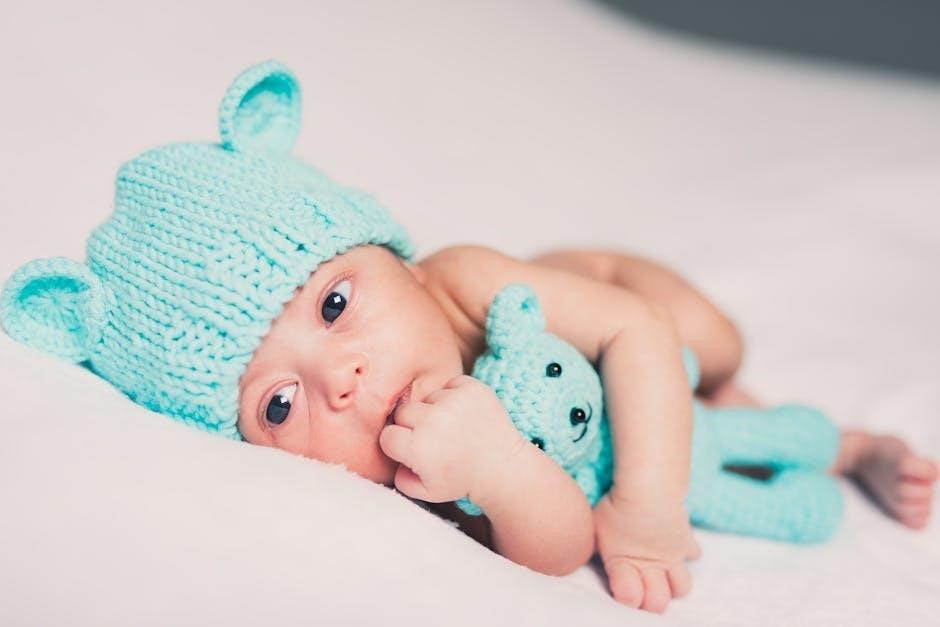
Common Mistakes in Crochet Beanie Sizing
Common mistakes include ignoring pattern specifics, incorrect gauge measurement, and not accounting for yarn weight differences, leading to ill-fitting beanies․ Proper attention to these details ensures success․
Incorrect Gauge Measurement
Incorrect gauge measurement is a common mistake that can drastically affect the fit of your crochet beanie․ Gauge refers to the number of stitches and rows per inch, and mismatched gauge can result in a beanie that is too tight or too loose․ To ensure accuracy, always use the recommended hook size and yarn weight․ Measure gauge by crocheting a swatch, then counting stitches and rows in a 4×4 inch area․ Consistent tension is key; loose or tight stitching can skew results․ Double-checking gauge before starting ensures a well-fitting beanie․
Not Accounting for Stretch in Finished Beanies
Ignoring the natural stretch of crochet beanies can lead to poor fit․ Yarns like wool or cotton often have more elasticity than synthetic fibers, affecting how the beanie conforms to the head․ If patterns don’t account for this, the finished product may be too tight or too loose․ Stitch patterns also play a role; denser stitches resist stretch, while open patterns allow more flexibility․ Failing to consider these factors can result in a beanie that lacks comfort or doesn’t stay in place properly․ Always test yarn stretch before starting your project․
Ignoring Pattern Specific Instructions
Overlooking pattern-specific instructions can lead to sizing mismatches and poor fit․ Every crochet pattern is designed with particular yarn weights, hook sizes, and stitch patterns in mind․ Deviating from these guidelines, such as using the wrong hook size or substituting yarn without adjusting the pattern, can result in a beanie that is either too tight or too loose․ Always follow the recommended materials and instructions to ensure your finished project meets the intended size and fit․ This attention to detail ensures a professional-looking and comfortable beanie․
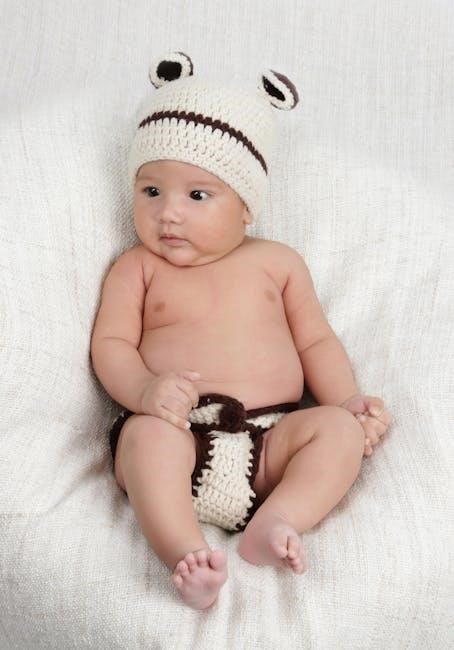
Adjusting Sizes for Different Yarn Weights
Different yarn weights significantly impact beanie size․ Bulky yarns create larger, faster projects, while finer yarns yield smaller, more detailed results․ Adjust hook size and gauge accordingly for consistent fit․
DK Weight Yarn Adjustments
DK weight yarn is a popular choice for crochet beanies due to its medium thickness and versatility․ To achieve the right fit, use a slightly larger hook size than recommended for lighter yarns․ Start with a gauge swatch to ensure accuracy․ DK yarn works well for both loose and tight stitch patterns, allowing for excellent drape and comfort․ For seasonal variations, pair DK yarn with breathable stitches in summer or denser patterns for winter․ This weight is ideal for creating beanies that are neither too bulky nor too delicate, making it suitable for most head sizes and preferences․
Worsted Weight Yarn Adjustments
Worsted weight yarn is thicker and warmer, making it ideal for winter crochet beanies․ To ensure proper fit, use a smaller hook size than recommended for lighter yarns․ This weight yarn creates a dense fabric, so loose stitches may result in a too-large beanie․ Opt for tighter stitch patterns like the half-double crochet for a snug fit․ Worsted weight yarn holds its shape well, making it perfect for structured beanies․ For added warmth, layer stitches or add a brim for extra thickness․ This yarn is great for creating durable, long-lasting beanies with excellent stitch definition․
Fingering Weight Yarn Adjustments
Fingering weight yarn is lightweight and fine, ideal for summer beanies or baby hats․ It creates a delicate fabric, so use a smaller hook size to maintain tension and prevent looseness․ Tighter stitch patterns, like single crochet, work best to avoid a too-slack fit․ For added warmth, layer stitches or incorporate textured patterns․ Fingering weight yarn is versatile but may require more stitches for a snug fit․ It’s perfect for intricate designs but can be time-consuming due to its finer texture, ensuring a lightweight yet durable finished product․

Understanding Beanie Stretch and Fit
Beanies require a balance of stretch and fit for comfort․ Natural fibers like wool offer more elasticity, while synthetic yarns may be less forgiving․ Looser stitches enhance stretch, ensuring a comfortable, snug fit without tightness․
How Fiber Content Affects Stretch
Fiber content significantly impacts the stretch of crochet beanies․ Natural fibers like wool and cotton offer excellent elasticity, allowing the beanie to stretch and recover shape․ Synthetic fibers, such as acrylic, provide moderate stretch but may lack the same resilience․ Blends of natural and synthetic fibers often strike a balance, offering both durability and flexibility․ The choice of yarn directly influences the beanie’s comfort and fit, making it essential to select fibers that meet the desired stretch and wearability for the intended use․
Loose vs․ Tight Stitch Patterns
Loose stitch patterns create a slouchy, relaxed fit with more stretch, while tight stitches provide a snug, fitted beanie․ Loose stitches allow for greater flexibility and a casual look, making them ideal for styling․ Tight stitches ensure a secure fit and are perfect for colder climates․ The choice between loose and tight stitches depends on the desired style and comfort level․ Proper tension ensures the beanie retains its shape while offering the right amount of stretch for a comfortable, flattering fit․
Adding Elasticity for Better Fit
Elasticity enhances comfort and ensures a secure fit by allowing the beanie to stretch without losing shape․ Techniques like ribbing, stretchy stitches, or seamless construction maintain flexibility․ Ribbing, with its alternating knit-like texture, naturally provides give, while certain crochet stitches, such as herringbone or chevron, inherently offer stretch; Incorporating elastic yarns or adding an elastic band can further improve fit․ Balancing elasticity with structure ensures the beanie stays comfortable yet snug, accommodating various head sizes and personal style preferences for a tailored look․
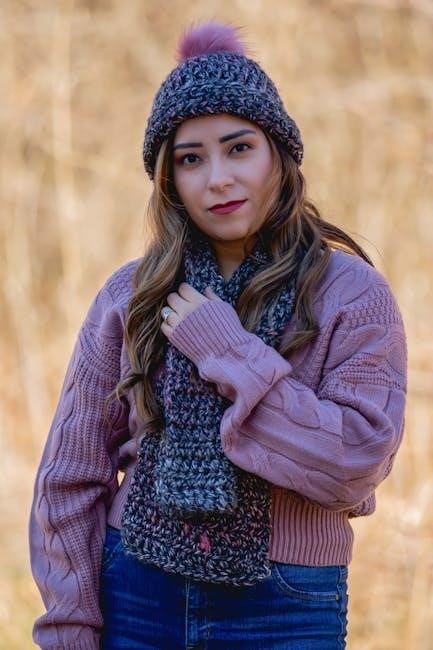
Seasonal Crochet Beanies and Sizing
Seasonal beanies require adjustments in yarn weight and fit․ Summer styles use lighter yarns for breathability, while winter beanies opt for thicker yarns and snug sizing for warmth․ Adjusting sizes ensures a perfect fit for layering during colder months․
Summer Beanies: Lighter Yarns and Looser Fits
Summer crochet beanies prioritize comfort and breathability, using lighter yarns like cotton, linen, or bamboo․ These materials keep heads cool while still offering UV protection․ Looser fits are ideal for warmer weather, allowing airflow and a relaxed style․ Popular styles include slouch hats and panama-inspired designs․ When choosing yarn, ensure it drapes well and maintains shape without being too tight․ Stitch patterns like lace or mesh can enhance airflow, making summer beanies practical and stylish for casual outings or layering over hairstyles․
Winter Beanies: Thicker Yarns and Snug Fits
Winter crochet beanies are designed for warmth and comfort, utilizing thicker yarns like wool, fleece, or chunky acrylics․ These yarns provide excellent insulation against cold temperatures․ Snug fits are essential to retain heat and ensure the beanie stays in place under coats or scarves․ Look for patterns that balance snugness with comfort to avoid tightness․ Consider using ribbing or elastic stitches for added stretch․ Always choose yarns with good stitch definition to maintain shape and durability․ Proper sizing ensures warmth without sacrificing style, making winter beanies both functional and fashionable․
Adjusting Size for Layering Purposes
When crocheting beanies for layering, consider how they’ll be worn over other hats or under hoods․ Measure the head with any layered items to ensure a comfortable fit․ Thicker yarns and looser stitches can add bulk, so adjust patterns to accommodate without sacrificing snugness․ Choose yarns that maintain shape while allowing flexibility․ Slightly increase the circumference and height to prevent tightness․ This ensures the beanie remains cozy and functional, even when layered, while maintaining its stylish appeal for cold weather wear․

Customizing Your Crochet Beanie Fit
Customizing fit involves adjusting patterns, yarn weights, or stitch types to suit individual preferences․ Techniques like adding ribbing or shaping ensure a personalized, comfortable fit for any head size․
Adding Ribbing for a Better Fit
Adding ribbing to your crochet beanie enhances fit and comfort․ Ribbing patterns, such as single crochet or half double crochet stitches, create elasticity․ This technique ensures the beanie sits snugly on the head without being too tight․ Ribbing also adds a stylish texture and can be customized in width and stitch type․ For a more tailored look, adjust the number of starting stitches or add ribbing rounds before transitioning to the main body of the beanie․ This method is especially useful for achieving a precise, comfortable fit․
Using Different Stitch Patterns for Shape
Different stitch patterns can significantly alter the shape and appearance of your crochet beanie․ Techniques like herringbone, chevron, or texture stitches create unique silhouettes, from slouchy to fitted styles․ By varying stitch density and arrangement, you can achieve a more rounded, elongated, or asymmetrical shape․ Adjusting stitch patterns also allows for customization to suit individual preferences or seasonal trends․ Experimenting with cables, waves, or spiral stitches adds visual interest while maintaining the structural integrity of the beanie․ This versatility ensures your project stands out with a personalized touch․
Embellishments and Their Impact on Sizing
Embellishments like pom-poms, tassels, or buttons can add style but may affect sizing․ Bulkier embellishments can tighten the fit, while flat ones have minimal impact․ Measure the beanie after adding embellishments to ensure proper fit․ Adjust stitch counts or sizing if needed․ Lightweight embellishments are ideal for maintaining size accuracy, while thicker ones may require pattern adjustments․ Balancing aesthetics and fit ensures your crochet beanie looks great and wears comfortably, making it both functional and visually appealing․

Troubleshooting Common Sizing Issues
Identify and fix sizing problems by adjusting stitches, measuring gauge, or rechecking head circumference․ Ensure proper fit by addressing tightness or looseness early in your project․
Minor tweaks can make a big difference in comfort and appearance․
Beanies That Are Too Tight
A too-tight beanie can cause discomfort and ruin the overall look․ This issue often arises from incorrect gauge measurements, using a hook size that’s too small, or tight stitching․ To fix this, try rechecking your gauge and switching to a larger hook․ Loosening your stitch pattern or adding extra stitches in the next round can also provide a more comfortable fit․ Ensuring proper stretch is key, especially for materials like acrylic or blends․ Adjusting early on will save time and ensure your beanie is both stylish and cozy․
Beanies That Are Too Loose
A beanie that is too loose can lack structure and fail to stay in place․ This issue often stems from a gauge that is too loose, using a hook size that is too large, or a stitch pattern that is too open․ To fix this, try switching to a smaller hook or adjusting your stitch pattern for a tighter fabric․ Decreasing the number of starting stitches or adding more decreases during shaping can also help achieve a better fit․ Proper tension and accurate gauge measurements are essential for a beanie that stays put and looks great․
Fixing Uneven Shaping
Uneven shaping in crochet beanies can result from inconsistent increases, decreases, or stitch alignment․ To correct this, ensure increases and decreases are evenly spaced and symmetrical․ Blocking the finished beanie can help even out the shape․ Checking gauge is crucial, as tension discrepancies can lead to asymmetry․ Additionally, maintaining consistent stitch patterns and properly aligning seams during joining will contribute to a more balanced and professional finish․ Adjusting your technique in these areas will help achieve a smoother, more uniform shape․
Achieving the perfect crochet beanie fit requires careful attention to measurements, gauge, and customization․ By understanding your head size, using accurate swatches, and adjusting patterns as needed, you can create beanies that are both comfortable and stylish․ Troubleshooting common issues like uneven shaping or improper stretch ensures a polished finish․ With practice and patience, you’ll master the art of crochet beanie sizing, resulting in projects that fit beautifully and bring pride to your handmade creations․